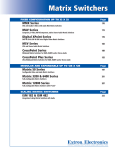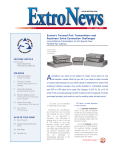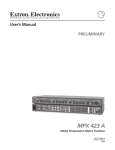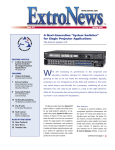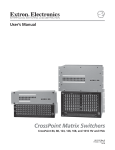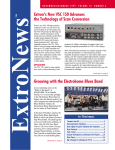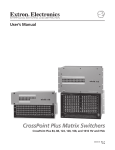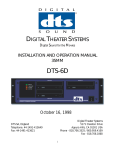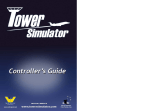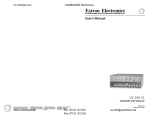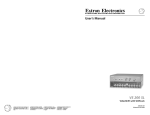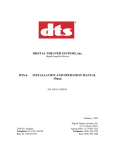Download November/December 2000
Transcript
www.extron.com Issue 11.4 November • December 2000 CrossPoint Plus Series Matrix Switchers “Single-Box” Solutions for Ultra-Wideband Routing Applications Extron’s CrossPoint Plus 128HVA Switcher FEATURE ARTICLES On the cover... CrossPoint Plus Series Switchers 4 Accu-RATE Frame Lock™ COLUMNS 5 The Extron Hotline: Thanks for Another Milestone I magine this scenario: you’re off-site, but you need to monitor the activities of your matrix switching system. 6 Technically Speaking... Demystifying Cables and Connectors for Digital Formats (Part 2) 10 Unique Techniques: Matrix Switching and Interfacing at NASA FutureFlight Central 16 Rental & Staging Corner: How would you do that? If you’ve installed an Extron CrossPoint Plus Matrix Switcher, then you can take advantage of its innovative Digital Sync Validation Processing (DSVP) feature. A/V in the Legal World 18 Tech Corner: Digital Sync Validation Processing (DSVP™) ALSO IN THIS ISSUE 12 New Products 15 Special Videoconferencing Series 20 New News 24 Tweeker Use DSVP verifies active sources by scanning all RGBS and RGBHV inputs for active sync signals. DSVP then transmits the horizontal and vertical scan rate information to you via any type of control system using RS-232/422 commands. This is useful for remote monitoring and diagnostics of the CrossPoint Plus and its sources. (For additional discussion, please visit Tech Corner on page 18.) CrossPoint Plus Series Matrix Switchers For applications that require uncompromised video bandwidth, Extron’s CrossPoint Plus Series Matrix Switchers combine the most popular features of the original CrossPoint Series with these newly added features: 450 MHz (-3dB), minimum, ultra-wideband video bandwidth; DSVP; front panel I/O label windows; view I/O mode; I/O grouping; audio attenuation/gain; channel to channel isolation; front panel security lock-out; and TripleAction Switching™. continued on page 2 CrossPoint Plus Series Switchers (cont.) RS-232 Input 01 02 03 04 05 06 07 08 09 10 11 12 Horz. 31.50 31.50 31.50 48.01 48.01 48.01 48.01 61.55 61.55 61.55 61.55 61.55 Vert. 60.00 60.00 60.00 67.50 67.50 67.50 67.50 72.00 72.00 72.00 72.00 72.00 MATRIX INPUT STATUS Input # 01 Input # 02 Input # 03 Signal: PRESENT Sync Type: H&V Vertical Freq.: 60 Hz Horz Freq.: 31.5 kHz Signal: PRESENT Sync Type: H&V Vertical Freq.: 60 Hz Horz Freq.: 31.5 kHz Signal: PRESENT Sync Type: H&V Vertical Freq.: 60 Hz Horz Freq.: 31.5 kHz Input # 05 Signal: PRESENT Sync Type: H&V Vertical Freq.: 67.5 Hz Horz Freq.: 48.01 kHz Input # 06 Signal: PRESENT Sync Type: H&V Vertical Freq.: 67.5 Hz Horz Freq.: 48.01 kHz Input # 07 Signal: PRESENT Sync Type: H&V Vertical Freq.: 67.5 Hz Horz Freq.: 48.01 kHz Input # 04 Signal: PRESENT Sync Type: H&V Vertical Freq.: 67.5 Hz Horz Freq.: 48.01 kHz Input # 08 Signal: PRESENT Sync Type: H&V Vertical Freq.: 72 Hz Horz Freq.: 61.55 kHz Input # 09 Input # 10 Input # 11 Input # 12 Signal: PRESENT Sync Type: H&V Vertical Freq.: 72 Hz Horz Freq.: 61.55 kHz Signal: PRESENT Sync Type: H&V Vertical Freq.: 72 Hz Horz Freq.: 61.55 kHz Signal: PRESENT Sync Type: H&V Vertical Freq.: 72 Hz Horz Freq.: 61.55 kHz Signal: PRESENT Sync Type: H&V Vertical Freq.: 72 Hz Horz Freq.: 61.55 kHz OR 3rd Party Control System Computer or Internet Using RS-232 communications, the matrix switcher can send the DSVP information to either a third-party control system’s touch panel or a software program accessed through a PC or Web site. The cost-effective, high performance CrossPoint Plus Series Matrix Switchers are ideal for ultra wideband, analog highresolution computer-video applications routing RGsB, RGBS, or RGBHV video signals, HDTV, component video, S-video, composite video, and/or stereo audio. This series is available in the following fixed configurations: 8 x 4, 8 x 8, 12 x 4, 12 x 8, 16 x 8, and 16 x 16. Each I/O size is available as two different models: “HV” models for switching signals up to RGBHV and “HVA” models for switching signals up to RGBHV and two channel stereo audio (balanced or unbalanced). Designed for resolutions from 1280 x 1024 and up, the CrossPoint Plus Series maintains original signal integrity with its minimum 450 MHz (-3dB) video bandwidth, fully loaded. Each input and output is individually isolated and buffered. These input(s) can be switched to any one or all outputs with virtually no crosstalk or signal noise between channels. output selection. It’s easy to label the front panel I/O buttons; just use any Brother P-Touch labeler or Extron’s label software, which ships with every Extron matrix switcher. For added convenience, the view I/O mode allows you to easily see which individual inputs and outputs are actively connected. This mode is available from the front panel or through RS-232/422. To make installation and control even easier, I/O grouping allows the matrix to be virtually divided into smaller sub-switchers. This feature allows specific outputs—such as those designated for a specific video format—to be grouped together for convenient wiring and switching. And to save time, the CrossPoint Plus Series provides global presets, which are individual I/O configurations. These allow you to set up I/O configurations and recall them from memory for future use. Use either the front panel or RS-232/422 to save and recall your global presets. Audio Convenience Each input and output can be labeled with names, alphanumeric characters, or even color bitmaps for easy and intuitive input and 2 ExtroNews 11.4 Sources with different output levels aren’t a problem when using a CrossPoint Plus “HVA” model. “HVA” models allow you to set the level of audio gain or attenuation November/December 2000 (-15dB to +9dB) via RS- 232/422 or from the front panel. Adjust the individual input audio levels accordingly, to eliminate the noticeable volume differences between sources. (See diagram on page 3.) The CrossPoint Plus “HVA” models also offer audio follow or breakaway switching from the front panel or RS-232/422. Audio follow is the capability to switch an audio signal with its corresponding video signal. This feature allows any audio signal to be switched with any video signal simultaneously to one or more outputs in any combination. Audio breakaway is the capability to break away an audio signal from its corresponding video signal. Audio breakaway is often used when the audio and video sources comprising a presentation are not generated by the same source. Control Controlling any system is easy with the CrossPoint Plus. Front panel buttons and RS-232/422 control are available. The QuickSwitch Front Panel Controller (QS-FPC™) allows for touch-of-a-button input and output selection. With Extron’s QuickSwitch technology, there is no need to dBu +19 +16 +13 +10 +7 +4 +1 -2 -5 -8 -12 VU 15 12 9 6 3 0 -3 -6 -9 -12 -15 Low Audio Output Level dBu +19 +16 +13 +10 +7 +4 +1 -2 -5 -8 -12 VCR Audio Inputs CONTROL dBu +19 +16 +13 +10 +7 +4 +1 -2 -5 -8 -12 VU 15 12 9 6 3 0 -3 -6 -9 -12 -15 VU 15 12 9 6 3 0 -3 -6 -9 -12 -15 Output Level I/O CROSSPOINT Plus MATRIX SERIES SWITCHER with DSVPTM Audio System CrossPoint Plus Series Switcher No noticeable volume differences between sources CD Jukebox High Audio Output Level conquer a steep learning curve when mastering the I/O routing control of a matrix switcher. The intuitive QS-FPC uses a tactile front panel button for each input and output. For any routing changes, just push a button to select or deselect its input source or output destination. keypad and/or the MCP 1000 remote control panel. Both remote control options are easy to use and provide tactile buttons for quick selection. Use an MCP 1000 for one-button switching to a particular output and selecting global presets, or use an MKP 1000 to select a different input or preset. Extron’s Simple Instruction Set™ is provided for RS-232 control via Extron’s Windows-based control/virtualization software or a third-party control system. For RS-232/422 remote control from a PC, Extron ships our Windows-based control software with every matrix switcher. This icon-driven software uses a graphical, dragand-drop interface to make I/O configuration and other customization functions simple and convenient. It also offers an emulation mode for configuration of an off-site matrix switcher. You can then save the I/O configuration for future downloading to the matrix switcher, which also saves time and costs during the install. Security Additional remote control convenience may be provided by the MKP 1000 remote The CrossPoint Plus Series provides excellent isolation between channels and extremely low electromagnetic emissions. This security feature is perfect for minimizing signal leakage in high security or government environments. If a CrossPoint Plus Series Matrix Switcher is installed in an unsecured environment, you can take advantage of the executive mode (security lock-out) option. While in the executive mode, a special button combination is required to operate the front panel controller. This feature restricts access to users who know the security passcode, so unauthorized and/or inexperienced users can’t change any of the settings. The CrossPoint Plus allows you to adjust the audio gain/attenuation for each input, so volume levels are consistent across all sources. And more… Extron’s exclusive Triple-Action Switching, also known as RGB delay, eliminates glitches during switching. Triple-Action Switching mutes the output to the display when the matrix switcher switches to a new source. Each CrossPoint Plus Series Matrix Switcher is housed in a rack-mountable, 19" wide enclosure, and the 100-240 volt, autoswitchable, internal power supply provides worldwide power compatibility. The CrossPoint Plus Series offers off-theshelf, in-stock, single-box solutions to routing applications requiring uncompromised video bandwidth. When the best matrix for your particular application is required, the CrossPoint Plus Series delivers the highest performance and most cost-effective solution. Please call Extron for part numbers and pricing information. November/December 2000 ExtroNews 11.4 3 Image tearing caused by mismatched refresh rates Accu-RATE Frame Lock™ Picture this: in preparation for an annual investors’ meeting, you’ve just finished setting up several video sources: a switcher, scaler, and displays or projectors at the Widget World corporate headquarters. Everything is going smoothly and the system design is nearly ideal. You’re testing the system when the Widget World CEO stops by to take a look. You switch to the input from a video camera, which your assistant pans across the boardroom. To your embarrassment, the CEO notices that the system has a glitch: a severe case of video hiccups, which must be cured before tomorrow’s meeting. Image Tearing: When Frame Rate Conversion Goes Bad System 7SC RCP 1000 (Remote Control Panel) 4 ExtroNews 11.4 You have probably seen this situation before. The video “hiccupping” is known as an image tear—a transient ripple, blip, or freeze in a scaled video image. It is a common byproduct of scaling that is most noticeable in video that has motion elements, particularly when a video camera pans across a scene or someone moves quickly across the camera’s view. Image tearing is an artifact of frame rate conversion. Scalers convert video input of one format and resolution (such as NTSC or PAL interlaced video or RGB at 560 x 384 at 59.94 Hz) into output of another format and refresh rate (perhaps progressively scanned SGS 408 ECP 1000 (Event Control Panel) November/December 2000 RGB at 1024 x 768 at 60 Hz). To convert frame rates, a scaler must create or combine frames. An image tear occurs if the input frame rate is slower or faster than the output frame rate, and part of the old frame and part of the new frame are displayed at the same time during a refresh cycle. The Solution: Accu-RATE Frame Lock (patent pending) If the output frame rate can be matched exactly to the frame rate of the input with the most motion content, image tears can be eliminated completely. The Extron Accu-RATE Frame Lock (AFL™) (patent pending) sets and locks the output rate to the input rate. In the SGS 408, the scaler outputs video from all inputs in the selected format, but at a refresh rate identical to that of a designated input (input #1). The result is a completely tear-free output in a seamless switching system with a fixed video delay of only 1/4 frame. For other inputs here's what happens: still video is not affected because there is no visible change in frames. If you want to use multiple motion video inputs, such as several cameras, each of those inputs should be genlocked together for optimal performance. The SGS 408 can be used in applications where completely tear-free motion video must be output with glitch-free switching in a system containing both still and motion sources. The System 7SC can be set up with a different video type (motion or still forms of composite video, S-video, component video, or RGB) and a different refresh rate for each input without any need for genlocking motion video sources. In the System 7SC, Accu-RATE Frame Lock locks the output frame rate to the rate of the active input, which can be any one of the scaled (non-RGB) inputs. Accu-RATE Frame Lock is unique to these Extron products; this feature is not available anywhere else. T H E E X T R O N H O T L I N E by Jeff Gibson, Vice President of Sales Thanks for Another Milestone F or the past ten years, Extron has hosted a party during INFOCOMM. The party locations have ranged from a plantation in Florida to the Disneyland Hotel in California. This year, our tenth annual party was located someplace very special. We opened the doors to our newest building in Anaheim and threw a big “Backyard Bash.” Five thousand people filled our 110,000 sq. ft. facility to help celebrate another successful INFOCOMM International. Music filled the building when the Battle of the Bands took center stage, and the floors were covered with people dancing, talking, and having an all-together good time. Now that the Backyard Bash has ended, the building is full of new activities. Extron has successfully completed the first stage of expansion into our third Anaheim facility. The sound and lighting equipment from the INFOCOMM party has been replaced by PCs and telephones, and Extron’s product development engineers have taken the place of the band members on center stage. This new facility marks another milestone in Extron’s development as an organization. Back in 1995 when Extron first came to Anaheim, CA from Santa Fe Springs, we moved into a building that covered a modest 60,000 sq. ft. That building housed every Extron's new building in Anaheim, California component of our organization—sales, product development, engineering, and manufacturing. Many of us here at Extron can remember when our entire manufacturing facility occupied what is now a world-class training center for A / V professionals—the S3 Technical Institute. Today, Extron requires three separate buildings to house all of our Anaheim operations. One building is dedicated to sales, marketing, and training; the second is dedicated to manufacturing; and this new facility houses our product development, engineering, and tradeshow departments. To us, this move is a significant milestone for several reasons. One, it symbolizes healthy growth for both the industry as a whole and for us as a company. It also means we will be able to dedicate even more resources to training, engineering, and product development and to meeting the increasing demand for constantly evolving product designs. Most importantly, the new building represents opportunities for Extron to expand our level of service, support, and solutions that we can offer to help your business succeed. Extron owes our growth to the support and commitment of the dealers and consultants who work with our products, and we would like to extend our most sincere thanks to you all for your contributions to Extron’s success. We intend to put our new facility to full use in order to ensure Extron continues to offer you the best solutions and support available in the industry. As always, please feel free to contact your Extron Customer Support Representative with any recommendations or insights you may have on how we can further improve our commitment to your business. And thanks again for another milestone. November/December 2000 ExtroNews 11.4 5 T E C H N I C A L L Y S P E A K I N G . . . by Steve Somers, Vice President of Engineering Demystifying Cables and Connectors for Digital Formats Part 2 – DVI, Firewire, and USB 2.0 C abling for DVI, Firewire, and USB 2.0 is paramount for each format in order to provide you with the performance specified. Recall that DVI (Digital Visual Interface) is penetrating the computer-monitor interface market as flat panel LCD monitors become affordable. Firewire, or IEEE-1394, is that tiny, bundle. When the DVI specification is square-like connector tucked away on the extended to the dual mode operation, side of your digital camcorder that allows greater data rates for higher display you to upload DV format to your resolutions are possible, but now there computer, among other things. And as we are seven parallel differential, high-speed approach the real beginning of the pairs. Cabling and connection become millennium (2001), USB is receiving a extremely important. In this way, DVI is major overhaul…analogous to jacking up similar to the original D1 parallel interface your radiator cap and driving in a new car which requires eight or ten differentially underneath it. Yes, USB 2.0 promises to driven serial lines capable of handling a bring hosted full byte on each clock cycle. If you have peripherals now capable of talking at 480 the opportunity, take a look at available Mbps instead of just 12 Mbps. D1 cables, and you will find them limited us hot swappable, in usable lengths—very much like DVI. Getting From Here To There With DVI The nominal DVI cable length limit is 4.6 meters (about 15 feet). Electrical The DVI (Digital Visual Interface) performance requirements are similar to connection between local monitors and serial digital. Signal risetime (0.330 computers presents interesting nanoseconds), cable impedance (100 interfacing environment. It a ohms), far end crosstalk (FEXT) of no combination serial digital interface and a more than 5%, and signal risetime parallel interface format, somewhat like degradation (160 picoseconds maximum) combining the broadcast serial digital and are the key parameters highlighted in the parallel digital interfaces. DVI specification regarding the physical an is connection. Cable for DVI is application Transmission of the TMDS (transition specific because maintaining these minimized differential signaling) format specifications is no easy feat since the combines four differential, high-speed actual bit rate per channel is 1.65 Gbps. serial And, connections (in its base configuration) transmitted in a parallel 6 ExtroNews 11.4 November/December 2000 we’re cable here. talking twisted pair T E C H N I C A L L Y S P E A K I N G . . . Those of you familiar with CAT 5, CAT transmission. The “eye” pattern seen at digital monitor interfacing should be 5e, CAT 6, and CAT 7 (I feel like someone the receiver end must be as symmetrical as gradual with capability to support the with too many cats), know the importance possible. Further, the inter-pair skew, analog VGA for some time. Therefore, of cable and installation quality in order to which governs how bits will line up in time there is a DVI-D (Figure 1) version for meet performance. For CAT 6, the industry at the receiving decoder, may only be 0.6 x digital interfacing only and a DVI-I version is talking 1 Gbps over four twisted pair pixel time, or 3.64 nanoseconds. These (Figure 2), which contains both analog wires over a distance of 100 meters. parameters are largely responsible for the and digital interfaces. Neither version is Sound something like DVI in terms of pairs short transmission distances for DVI. like the earlier DFP connector. and speed? And, the trend is to push for faster communication speeds. This makes In addition to the above requirements, a these methods very similar in speed with cable for DVI should be evaluated on its DVI, but that’s where the similarity ends. In insertion loss for a given length. The DVI high-speed data communications systems, transmitter output eye pattern is specified there is significant overhead added to into a nominal cable impedance of 100 handle error correction. And, if some data ohms. A normal signal swings +780 mV to is lost, it can be re-sent. With digital video –780 mV. The minimum positive signal interfaces like DVI, there is some error swing is +200 mV and the minimum correction facility, but the delivery is a one- negative swing is –200 mV (total swing of way street. If you fail to receive all the data 400 mV). When the signals are combined bits required to make the system work, in the differential receiver, the resulting you lose picture information or lose the signal level is two times the swing value. picture completely. But, for the cable situation, we must 1 8 17 24 9 DVI-D 1. Receptacle Connector Figure DVI-D Receptacle Connector 1 8 17 24 C1 C2 9 C5 C3 C4 DVI-I Receptacle Connector Figure 2. DVI-I Receptacle Connector assume minimum performance on the DVI-D embodies 24 pins supporting the So, the DVI cable and its termination is transmitter side and best sensitivity on the digital-only version. The combined digital very important. The physical parameters of receiver end. The receiver must operate on and analog version, DVI-I, adds four the twisted pairs must be highly signals as low as +75 mV to –75 mV, or a additional controlled. Specifications for the cable and total swing of 150 mV. This means that supporting analog RGB and horizontal the receiver are given in fractions of bit under worst-case conditions, the cable sync, plus a fifth connection for ground. transmission the attenuation can be no more than 8.5dB at The combination connector is intended to requirements depend on the clock rate or 1.65 GHz (10 bits/pixel times 165 MHz transition product from analog to the fully signal resolution being used. Transferring clock). As you can imagine, maintaining digital the maximum rate (1600 x 1200 at 60 Hz) this type of performance on twisted pair arrangement in the digital portion of the for a single link system means that one bit wires is relatively difficult. connector supports logical arrangement of time. Therefore, time (10 bits per pixel) is 0.1(1/165 MHz), which is only 0.606 nanoseconds. Ten bit times describe one pixel in this system. segregated connection over connections time. Pin the differential pairs to support the high DVI Connector – All For One and Two For All data rate. Although the DVI-I connector has many pins, it is not much larger than Two versions of the connector emerged The DVI receiver specification allows from its creator—the DDWG (Digital only 0.40 x bit time, or about 0.242 Display Working Group; more details and nanoseconds intra-pair skew (within the full specs at www.ddwg.org). The DDWG twisted pair). Remember, this is differential felt that the transitions from analog to November/December 2000 continued on next page ExtroNews 11.4 7 T E C H N I C A L L Y S P E A K I N G . . . Figure 3. IEEE 1394 4-pin the current 15-pin HD VGA connector. The 1394 specification limits cable Currently, termination of the connector is length to 4.5 meters in order to satisfy the challenging due to the tooling and limited round trip time maximum required by the space within the assembly. The DVI arbitration protocol. Some applications connector is allowed a maximum of 0.160 may run longer lengths when the data rate nanoseconds risetime degradation to the is lowered to the 100 Mbps level. The signal. typical cable has 28 gauge copper twisted pairs and 22 gauge wires for power and Figure 4. IEEE 1394 6-pin DV and Firewire – Serial Digital for the Rest of Us ground. A Firewire connected appliance The new DV, or Digital Video, recording but must be capable of providing limited standard now driving most consumer power for downstream devices. The 1394 camcorder purchases, is a serial digital specification may or may not need power from its host, supports two plug format of 25 Mbps, sometimes called configurations—a four-pin version (Figure 3) DV25. The Firewire (IEEE 1394) interface and a six-pin version (Figure 4). Six-pin conveniently handles the data rate of DV, versions can carry all six connections and and then some. The DV format is the first are capable of providing power to application making tremendous use of the appliances that need it. For independently IEEE 1394 capability. IEEE 1394 is much powered appliances, like camcorders, the bigger than DV in terms of data handling. four-pin This specification supports up to 400 Mbps compactness. Cable assemblies have the currently and extensions to the standard data signal pairs crossed over to avoid are under consideration. Its key strengths polarity issues. All 1394 type appliances are its “just-in-time” data delivery and have receptacles, which makes for easy peer-to-peer relationship…meaning that upstream-downstream connection with Firewire appliances can communicate the male-to-male cable. version is used for its without need for a host controller. The So, when we talk DV, we are really Power supply (8 to 40 V. maximum DC current: 1.5 A) Twisted pair signal lines: two sets Cable shielding Signal line shield Figure 5. IEEE 1394 Cable 8 ExtroNews 11.4 electrical 1394 specification performance provides requirements, talking about using 1394 (I’m tired of which leave open the actual parameters of typing IEEE) and a portion of its capability. the cable design. As with all differential The connection scheme and cabling for signaling systems, pair-to-pair data skew is this interface are specific as well. The 1394 critical…≤ 0.40 nanoseconds. Crosstalk system utilizes two shielded twisted pairs must be maintained below –26 dB from and two single wires. The twisted pairs 1 to 500 MHz. The only requirement on handle differential data and strobe (assists the size of wire used is that velocity in clock regeneration) while the separate of propagation must not exceed wires provide power and ground for 5.05 nS/meter. Refer to Table 1 for other remote devices needing power support. critical details of the physical interface Signal level is 265 mV differential into system for 1394. Figure 5 shows the cable 110 ohms. internal conductor arrangement. November/December 2000 T E C H N I C A L L Y USB 2.0 – Fire In Another Wire propagation delay. The cable may have no The USB, universal serial bus, simplifies more than 26 nS delay from connector A connection of computer peripherals. USB to connector B. An additional allowance of 1.1 is limited to a communications rate of 4 nS is split between the sending device 12 Mbps, which is plenty fast for most connection items devices, connection/response function, making the keyboards, scanners, etc. During 1999 the entire one-way delay 30 nS maximum. In USB Implementers Forum began work to addition, the cable may not have a velocity upgrade USB capability by more than 40 of propagation greater than 5.2 nS per times. The new USB 2.0 interface will meter. The length and twist of the data support up to 480 Mbps communication. pair must be matched well enough so that It is anticipated that USB 2.0 can replace no more than 0.10 nS time skew exists higher cost SCSI interfaces for some between bit polarities. The nominal peripherals. In-depth information is differential signal level is 800 mV. like printers, audio S P E A K I N G . . . and the receiver available at www.usb.org. The digital video and data world is The Implementers Forum says that fully exciting, but, as you can see, assembling compliant USB 1.1 cables will perform at high-speed data cables is not going to be USB 2.0 speeds. USB cables utilize two a trivial or casual task. Why, I’ve just specially designed 4-pin plugs and gotten the hang of crimping on BNC receptacles. The “upstream” plug is called connectors. What do you think about USB “A” and the “downstream” plug is called on BNC? You need power? Well, with “B” (see Figure 6). This format is intended some external wires and a little Scotch to tape, we can… minimize problems, end thereby user termination ensuring A B Figure 6. USB “A” and “B” connectors proper connectivity. Use the A connector to connect with a host or downstream connection on a hub. Use the B connector to connect to the peripheral appliance. The USB cable consists of one twisted pair for data and two untwisted wires for Parameter 100 Mbps 200 Mbps 400 Mbps powering Max Tr/Tf 3.20 nS 2.20 nS 1.20 nS Bit cell time 10.17 nS 5.09 nS 2.54 nS Transmit skew 0.40 nS 0.25 nS 0.20 nS aluminized polyester shield, a drain wire, Transmit jitter 0.80 nS 0.50 nS 0.25 nS and an overall 65% (minimum) copper Receive end skew 0.80 nS 0.65 nS 0.60 nS braid. Nominal impedance for the data Receive end jitter 1.08 nS 0.75 nS 0.48 nS downstream appliances. Specifically, a full-speed cable contains a 28-gauge twisted pair, an untwisted pair of 28 to 20 gauge power conductors, an pair is 90 ohms. The maximum cable length for USB is a function of signal Table 1. Critical IEEE 1394 Timing Parameters November/December 2000 ExtroNews 11.4 9 U N I Q U E T E C H N I Q U E S Matrix Switching and Interfacing at NASA FutureFlight Central N ear Mountain View, CA, NASA Ames Research Center and the FAA collaborated on a full-scale air traffic control tower simulator named FutureFlight Central. FutureFlight Central tests out new ways of managing air traffic by simulating a real airport environment. A Silicon Graphics computer generates everything from weather patterns to mock take-offs and landings to help researchers plan the airports of the future. And a whole range of A / V devices work to pull the facility together. NASA FutureFlight Central’s tower cab displaying a panoramic view of San Francisco International Airport. Source: NASA Ames Research Center Beginning with the simulated air traffic control tower, large display screens from Stewart Filmscreen provide a 360˚ view of the computer-generated tarmac. These screens are actually placed behind 1/4 inch tempered-glass windows to make the facility seem more real. CRT projectors from Electrohome (now part of Christie Digital) are used to display the simulated environment created by the SGI Onyx Reality Monster. Controlled by a Crestron system, the video system is comprised of two sub-systems. The first sub-system is made of thirty-six RGsB and two component video sources and forty-one RGsB and three component video destinations. The second sub-system contains thirty-seven composite video sources and thirty-four composite video destinations. Composite Video System The video sources are CATV (cable television), VCRs, a DVD player, a laserdisc player, and observation cameras. Most of the video is in composite NTSC color format. The source materials include videotapes of the tower simulations, videotapes for presentations and public relations, and video of computer images for distribution on vid-net, the NASA internal base CATV system. The composite video sources are routed through Extron’s Matrix 6400 to various destinations, such as recording VCRs, monitors located around the facility, and the projector in the Briefing Room. RGsB and Component Video System To generate the computer-simulated tarmac, the SGI system takes data from satellite images, digitized photos, and architectural plans. This information enables FutureFlight Central to operate as a usability lab and conduct research on possible ways to improve airport operations. There are six PCs to simulate images from airport “DBRITE” 10 ExtroNews 11.4 November/December 2000 U N I Q U E radar systems, which are displayed on six hanging monitors in the tower cabin. There are also many wall and floor plates to plug any computer into the system to generate images. All the computer-video and RGB signals are in RGsB format. Component video is used for a limited number of runs between the Betacam deck, preview monitor, scan converter, and line doubler. T E C H N I Q U E S Conceptual illustration of NASA FutureFlight Central’s tower cab/projection room. Source: NASA Ames Research Center Matrix Switching Three 48 x 48 Matrix 6400 Basic Module Enclosures (BMEs) are used for the red, green (with sync), and blue signals, as well as component video (Y, R-Y, B-Y). The fourth Matrix 6400 BME routes composite video. The three RGsB/component video BMEs share one control panel and operate together. The composite video BME has its own control panel. Most switching is done directly via the Crestron control system. Virtual “rooms” were set up for the twelve tower outputs and the two sets of six monitors. Rooming is a feature that allows specific outputs (such as those in one room) to be grouped together so that they may select inputs independently of the rest of the matrix switcher. “This enabled us to set up presets, for example, to make simultaneous switches of all outputs to the tower projectors for common configurations,” commented Eric Neuman, Intellisys Group’s (now part of MCSi) Director of Technical Services – Mountain View. Intellisys designed and installed the A / V system at FutureFlight Central. Neuman explained that the Matrix 6400 was chosen because it offered the size needed with the field-expandability required by the contract—in a single chassis—in addition to the high video bandwidth that was required. Two other important features were reliability and accessibility; Neuman recounted, “All the boards are accessible from the front panel without disconnecting the signal cables.” Interfacing and Sync Processing Extron’s RGB 109 Plus computer-tovideo interfaces (now replaced by the RGB 109xi) were chosen because they were dedicated interfaces (perfect for the dedicated computers—the DBRITES) and they output RGsB signals. Neuman added, “Their LCD readouts are also useful for verifying valid input signals.” Extron’s RGB 202xi universal interface (now replaced by the RGB 202 Rxi) was chosen for its flexibility in adapting to any computer input source, including PCs, Macs, SGI, and Sun SPARC workstations. Additional strong points were the LCD readout, RGsB output, and available image position adjustments. Extron’s SC 110 sync processors and stabilizers (now replaced by the SC 210) convert the RGsB format signal to RGBHV format for the line doublers that do not accept RGsB. Extron’s VTG 200 video test generator was installed to provide a test signal for the RGsB/component video system and the composite video system. These test signals verified operation of the system and also were used for projector setup and matching. FutureFlight Central was well-received at its opening. As for its A / V system—“They love it [the Matrix 6400]. It accommodates all their current requirements, allows for future expansion, and we haven’t had any trouble calls since we completed our contract,” noted Neuman. For more information about FutureFlight Central, please visit http://ffc.arc.nasa.gov November/December 2000 ExtroNews 11.4 11 N E W P R O D U C T S 90º 15-pin HD Cables with Audio BNC Extraction Tool BNC Connector BNC Extraction Tool F R O M E X T R O N The Extron 90˚ 15-pin HD Cables with Audio directly connect video and audio from computers to 15-pin HD interfaces, distribution amplifiers, switchers, or displays mounted in A / V racks, walls, tabletops, or other locations. These cables can also be used as VGA extension cables. The 90˚ 15-pin HD Cables with Audio provide lowprofile, clean-looking cable connections for small spaces and high traffic areas. The 90˚ angle allows the cable to lie flat, protecting it from accidental damage, such as getting snagged or caught on obstacles. Stressreducing strain reliefs provide added strength and durability. All audio inputs and outputs use 3.5 mm stereo audio connectors. These 90˚ 15-pin HD Cables with Audio are available in 3', 6', and 12' lengths. The Extron BNC Extraction Tool is a handy, 12-inch (30.5 cm) tool for extracting BNC connectors in tight spaces. BNCs disconnect with a quick twist of the wrist, so using the BNC Extraction Tool saves time and effort (and fingertips). When equipment is dismantled for any A / V application, such as a staging event or an installation upgrade, speed is essential to minimize downtime for the technicians and A / V equipment. In situations with difficult-toreach BNCs, especially when cables are already connected to back panel BNCs on rackmounted hardware, technicians no longer need to risk developing hand cramps or soreness while disconnecting numerous BNC connectors. The BNC Extraction Tool is now an included accessory item for each of these matrix switchers: CrossPoint 168 and 1616 Series Switchers, all models of CrossPoint Plus Series Switchers, and Matrix 3200 and 6400 Wideband and Video Switchers. This tool is also available separately as an optional accessory item. 90˚ 15-pin HD Cables with Audio Please call Extron for part number and price. 12 cables available in various lengths and configurations. URL: www.extron.com/90degcable BNC Extraction Tool Part Number: 100-096-01 List Price: $60.00* (US Dollars) URL: www.extron.com/bncextractiontool * Prices valid for US sales only. SVDA 6 A MX One Input, Six Output, S-video and Stereo Audio Distribution Amplifier The Extron SVDA 6 A MX is a one input, six buffered output distribution amplifier. It distributes S-video (S-VHS) and stereo audio signals. The SVDA 6 A MX offers the convenience of a combination S-video and stereo audio DA in one half rack width, 1U high, rack mountable enclosure. For signal distribution in professional A / V systems and home theaters, the SVDA 6 A MX distributes the NTSC, PAL, or SECAM signal of any video source, such as a camera, VCR, or DVD player. The S-video output of a video source can be split into six different, independently buffered outputs. The SVDA 6 A MX also accepts and outputs balanced or unbalanced stereo audio signals for maximum 12 ExtroNews 11.4 November/December 2000 performance, flexibility, and ease of integration into the A / V system. The SVDA 6 A MX provides 4-pin mini DIN connectors for S-video and 3.5 mm captive screw connectors for stereo audio. It includes a 100-240VAC, 50/60 Hz, auto-switchable, internal power supply. SVDA 6 A MX Part Number: 60-353-01 List Price: $625.00* (US Dollars) URL: www.extron.com/svda6amx * Prices valid for US sales only. N E W SW 6 SV A MX and SW 6 SV A MX AUTO Six Input, Two Output, S-video and Stereo Audio Switcher SW 6 SV A MX CD 900 Quad-Standard Decoder P R O D U C T S The Extron SW 6 SV A MX is a six input, two output switcher. It distributes S-video (S-VHS) and stereo audio signals. The SW 6 SV A MX offers the convenience of a combination S-video and stereo audio switcher in one half rack width, 1U high, rack mountable enclosure. The SW 6 SV A MX is also available in an auto-switch version, the SW 6 SV A MX AUTO. For signal routing in professional A / V systems and home theaters, the SW 6 SV A MX switches up to six NTSC, PAL, or SECAM signals from video sources such as cameras, VCRs, or DVD players. This capability allows the user easy selection between S-video and stereo audio sources. The SVDA 6 A MX also accepts and outputs balanced or unbalanced stereo audio signals for maximum performance, flexibility, and ease of integration into the A / V system. Two independently buffered outputs allow for simultaneous display on a projector and a monitor. The Extron CD 900 is a professionalquality quad-standard video decoder. Replacing the CD 800, the CD 900 includes all the features of the CD 800 and adds component video output. The CD 900 decodes composite or S-video to component video (Y, PB, PR) or RGB video (RGBHV, RGBS, or RGsB) for enhanced images. Designed for commercial A / V or home theater environments, the CD 900 decoder can be used in applications that use a video source for a component video or RGB presentation monitor or projector. The CD 900 can also be used to integrate composite video and S-video sources into component or RGB video switching and distribution systems. The CD 900 accepts NTSC 3.58, NTSC 4.43, SECAM, and PAL interlaced composite video or S-video. To provide a crisp, clean image of higher quality than that of composite video or S-video, and to reduce chroma noise, the CD 900 uses an enhanced decoder chip with a three-line adaptive comb filter. F R O M E X T R O N The SW 6 SV A MX provides RS-232, front panel, or contact closure control. It includes genlock capability to provide seamless vertical interval switching for genlock-compatible sources. The SW 6 SV A MX provides 4-pin mini-DIN connectors for S-video and 3.5 mm captive screw connectors for stereo audio. It includes a 100-240VAC, 50/60 Hz, autoswitchable, internal power supply. SW 6 SV A MX and SW6 SV A MX AUTO SW 6 SV A MX Part Number: 60-358-01 List Price: $995.00* (US Dollars) SW 6 SV A MX AUTO Part Number: 60-358-02 List Price: $1,195.00* (US Dollars) URL: www.extron.com/sw6svamx * Prices valid for US sales only. The composite video or S-video input can be selected via front panel buttons, RS-232 control, contact closure control, or the autoswitching feature. Color, tint, contrast, and horizontal shift picture controls are provided. For each of the two inputs, the settings for the picture controls are automatically saved in non-volatile memory. The appropriate picture settings are recalled automatically when an input is selected. CD 900 Part Number: 60-355-01 List Price: $1,595.00* (US Dollars) URL: www.extron.com/cd900 * Prices valid for US sales only. November/December 2000 ExtroNews 11.4 13 N E W P R O D U C T S DDTX/DDRX DVI Direct Digital DVI Transmitter/Receiver Set DDTX DVI (Transmitter) DDRX DVI (Receiver) D/2 DA4 DVI Direct Digital DVI Distribution Amplifier 14 ExtroNews 11.4 F R O M E X T R O N The Extron DDTX/DDRX DVI is a Digital Visual Interface (DVI) transmitter-receiver set designed for long-distance transmission of DVI signals between a DVI source and DVI display. The set consists of a digital transmitter (DDTX DVI) and digital receiver (DDRX DVI), both capable of handling bit rates up to 1.6 gigabits/sec/color. The DDTX/DDRX DVI accepts transmission minimized differential signaling (TMDS) DVI/DFP signals, which are normally limited to a maximum distance of 15 feet. It will accept Digital Flat Panel (DFP) signals with the use of DFP-to-DVI adapters. The DDTX/DDRX DVI set uses proprietary digital technology to compensate for signal losses and ringing. This system is entirely digital with no conversions to analog video at any point. The DDTX/DDRX DVI extends the range of DVI signals to up to 330 feet (100 m), depending on the type and quality of cable used. The maximum separation between the source and digital display is 330 feet (100 m) using Extron’s Super High Resolution Cable or 150 feet (45.7 m) using Extron’s Mini High Resolution Cable. The DDTX/DDRX DVI also implements bi-directional Display Data The Extron D/2 DA4 DVI is a one input, four output, Digital Visual Interface (DVI) distribution amplifier. It accepts DVI signals from a computer and distributes up to four identical, independently buffered outputs for cable runs of up to 15 feet. It will also accept Digital Flat Panel (DFP) signals with the use of a DFP-to-DVI adapter. The D/2 DA4 DVI is capable of handling transition minimized differential signaling (TMDS) signals at any bit rate up to 1.6 gigabits/sec/color. The D/2 DA4 DVI is ideal for applications requiring identical displays on multiple DVI monitors or projectors with identical resolutions and refresh rates. November/December 2000 Channel (DDC) communications between the source and digital display via Extron’s Plenum Comm-Link Cable. The DDTX/DDRX DVI set is equipped with DVI-digital connectors for a single link of DVI-digital. The transmitter and receiver use BNC connectors for signal connection between the two. The DDTX/DDRX DVI offers 3.5 mm captive screw connectors for DDC communications. The DDTX transmitter is rack mountable. The DDRX is housed in a small enclosure with a built-in mounting bracket for easy mounting at the projector. The DDTX has an internal power supply. The DDRX accepts 9-12VDC and uses an external power supply (included). DDTX/DDRX DVI Part Number: 60-316-02 List Price: $2,995.00* (US Dollars) URL: www.extron.com/ddtxdvi * Prices valid for US sales only. The D/2 DA4 DVI is equipped with DVIdigital connectors for a single-link system. It is rack-mountable and includes a 100-240VAC, 50/60 Hz, auto-switchable internal power supply. D/2 DA4 DVI Part Number: 60-315-02 List Price: $1,295.00 * (US Dollars) URL: www.extron.com/d2da4dvi * Prices valid for US sales only. S P E C I A L V I D E O C O N F E R E N C I N G S E R I E S Part 1: Scan Conversion for Videoconferencing Say you’re videoconferencing, and you want to show the far-end participants a PowerPoint presentation or an Excel spreadsheet. You’re going to need a scan converter. CENTERING/PAN GENLOCK MENU FREEZE/ RESET NEXT INPUT/LOOP OUT DIGITAL OUT G E N L O C K H HV MAC 100-240 Scan converters take high resolution computer video signals and convert them into a standard NTSC or PAL signal. By doing this, scan converters let regular TV monitors display a computer video signal. H/HV SOG V RS-232 REMOTE Codec INTERFACE RGB W 103 /ADSP xi INPUT LOCAL OUTPUT BUFFERED MONITOR H. MAC SHIFT INTERFACE RGB W 103 /ADSP xi That said, there are certain techniques you can use to optimize the scan-converted quality of the image in a videoconferencing application. To get the highest quality scan converted image possible, try these tips: B/B-Y S-video MAC On the most basic level, scan conversion involves removing or compressing portions of the original signal’s video information. As a result, the output video signal often appears to have less detail and sharpness than the original one. G/Y SHIFT Optimizing the Image for Scan Conversion R/R-Y H. That requires converting the computer video signal into a format the display device can use. This is where scan converting comes in. S-VIDEO VSC 200D LOCAL OUTPUT Computer video signals are a different story. There is a whole range of standards that applies to video signals generated by computers. The only general rule of thumb that applies when comparing computer video signals to conventional video is computer signals generally require more bandwidth. If you want to show your Excel spreadsheet to the far-end participants, the computer video signal will have to be squeezed down to meet the conventional video monitor’s standards for video display. VIDEO BUFFERED MONITOR Conventional video that’s displayed on a television monitor conforms to specific standards. Depending on where you live, that standard is NTSC, PAL, or SECAM. These standards define everything about the video signal—sync levels, video levels, colors, bandwidth, etc. VGA 50/60 Hz 0.5A IN OUT INPUT Why a Scan Converter? VSC 200 COMPUTER TO VIDEO SCAN CONVERTER Preview Monitor PC Computer INPUT OUTPUT RS-232 Control CONTROL Videoconferencing setup using Extron’s VSC 200D • Display PowerPoint slides and Excel spreadsheets with the computer set at 640 x 480 or as low a resolution as possible—NTSC signals run at approximately 720 x 480. By using a computer resolution that’s close to NTSC to display the slides, less information will have to be removed during scan conversion—meaning the displayed image will more closely match the image on your computer screen. • Use large fonts for any computerbased text (PowerPoint, Excel). • Use sans-serif fonts, like Arial. • Use a black border or line between adjacent colors to minimize chroma crawl. Setting Up the Scan Converter Adjusting the scan converter, as well, can greatly improve the appearance of the scan converted image. Most scan converters have multiple adjustments designed to optimize the output image for different image types and scan rates. To get the best image, follow these steps in order: 1. Select the output standard (NTSC or PAL) that’s compatible with your local system. 2. Size the image to fill the screen. If the image is sized properly and fills the screen entirely, the scan converter has more area to work with. This means that more information can be displayed on the screen. 3. Select the filtering levels. Use the horizontal, vertical, and encoder filtering controls (in that order) to select the filtering levels that give the best picture sharpness and the least amount of flickering. Adjusting horizontal filter levels can minimize detail loss, vertical filtering can reduce flicker, and encoder filtering can improve sharpness. Make sure the scan converter you purchase lets you manually adjust these levels separately. If you’re in a videoconference and the far-end participants can’t read the fine detail in an Excel spreadsheet or PowerPoint slide, this is probably a scan converter issue. Check to make sure you’ve followed the instructions for setting up the scan converter and optimizing the image. In the next issue of ExtroNews, we will explore more aspects of videoconferencing. In the meantime, if you have any videoconferencing concerns, call Extron at: 800.633.9876. November/December 2000 ExtroNews 11.4 15 R E N T A L & S T A G I N G C O R N E R A / V in the Legal World This past summer, at the US Federal Courthouse in Foley Square, Manhattan, New York, a bench trial (no jury) was held between the US Government and three major credit card companies. The temporary A / V system used during this three-monthlong antitrust court case was provided by Visual Word Systems of New York. Sources The four sets of attorneys representing the four parties involved in the case utilized Extron interfaces to connect a total of six computers to the A / V system. Taking advantage of the Extron RGB 202xi twoinput, universal computer-video interface (now replaced by the Extron RGB 202 Rxi), the attorneys used its switching capability by connecting only one laptop to each interface and leaving the second input unused. When they switched the RGB 202xi toggle switch to display the unused input, the output to the courtroom displays was blanked since there were no images from a second source to display. The attorneys were then able to preview images off-line on their laptops before flipping the toggle switch back to A/V installation by Visual World Systems at the US Federal Courthouse in Foley Square, Manhattan, New York 16 ExtroNews 11.4 display their images. The unused inputs also served as backup for connecting additional computers as needed throughout the trial. A Samsung digital document camera and compact Extron RGB 440 computer-video interface were located on a free-standing cart. XGA document images were transmitted by the document camera to the RGB 440. The RGBHV output was then routed to an Extron CrossPoint 128HV Matrix Switcher. The RGB 440 is a universal, architectural, interface that is mountable through or under a desk or almost any other flat surface. Ike Eckstein, president of Visual World Systems, explained his choice, “We picked the RGB 440 because of its size, its real estate value. It takes up the least amount of room.” The Extron DVS 100 (now succeeded by the DVS 150) video scaler upscaled the Sony VCR’s composite video to RGBHV for integration into the RGB A / V system. Matrix Switching The CrossPoint 128HV routed RGBHV signals from the interfaces and scaler to three NEC RGBHV flat panel displays and two distribution amplifiers. One Extron ADA 2 300 MX HV and one Extron ADA 4 300 MX HV distributed the RGBHV signals to the other flat panel displays and NEC CRT monitors for the attorneys, judge, clerk, and witness, as well as two NEC 37-inch CRT monitors for the gallery—a total of ten monitors. The CrossPoint 128HV is a twelve input, eight output matrix switcher that is able to route any signal to one or more outputs. Eckstein noted, “We picked this CrossPoint for its reliability and flexibility. Reliability was 100% important for a court November/December 2000 Extron RGB 440 Extron RGB 202 Rxi trial that depended on a flawlessly running A / V system. Plus you can easily program it for any [I /O] configuration.” Control The Extron MCP 1000 is compatible with any Extron matrix switcher. Two MCP 1000 remote control panels were used to control the CrossPoint 128HV. The plaintiff, the US Government, used one MCP 1000, and the defense attorneys shared a second MCP 1000. These MCP 1000s were hard-wired and could override any displayed image if there was an objection by either side. The MCP 1000s were preprogrammed and labeled for intuitive, one-touch selection so the current image could be selectively displayed to the judge, clerk, and/or galley. Extron MCP 1000 R E N T A L Witness Monitoring System Due to the layout of the courtroom, some attorneys were not able to see the witnesses without the aid of a CCTV (closed circuit television) monitoring system. A Panasonic video camera and an Extron CVDA 6 MX distribution amplifier were added to the A / V cart that held the document camera and its Extron interface. With one input and six outputs available, the CVDA 6 MX distributed the camera’s composite video signal to five Panasonic monitors located at the attorneys’ and the court clerk’s tables. & S T A G I N G the RGBHV signals. The document camera’s output was routed to the RGB 440 on 15-pin HD Cable. RS-232 Cable carried the serial communications between the MCP 1000s and the CrossPoint 128HV. Between the MCP 1000s, control communications were transmitted over Comm-Link Cable. C O R N E R Extron Comm-Link Cable Eckstein commented on the reliability of this elaborate courtroom A / V system. “We have not needed to swap out a single piece of equipment during the entire, almost three month-long trial... Technically it’s one of the smoothest setups we’ve ever done.” Extron BNC-5 Mini HR Cable Cables The courtroom A / V system used different types of Extron cable: BNC-5 Mini HR Cable, 15-pin HD Cable, RS-232 Cable, and CommLink Cable. The BNC-5 Mini HR Cable passed For more information, please contact Visual Word Systems at 212.629.8383 or [email protected]. Extron 15-pin HD Staging Cable Extron RS-232 Cable New Name, Improved Interface... “E-Demos” are Online! You told us how valuable the Extron “Webcasts” are—how effectively the high quality sound, graphics, and computer animation work together to demonstrate each product. You also told us that the name “Webcast” doesn’t do justice to the usefulness and content these tools deliver. We listened to your feedback and created a new name that better describes these multimedia presentations— Extron E-Demos. E-Demos can be easily accessed through the Extron Web site at www.extron.com. Now you can learn all about new products without leaving the comfort of your favorite Internet browser. These demos are excellent learning tools for sales personnel, installers, service professionals, and end users. Just point and click to control the demo for an instant presentation. Currently, the following E-Demos are available: Product Demo Posted • P/2 DA1 June 19, 2000 • RGB 202 Rxi June 19, 2000 • Introduction to Extron’s Webcasts June 20, 2000 • Extron’s Dealer-Only Site July 11, 2000 • SGS 408 July 11, 2000 • YCS Transcoder November 7, 2000 • System 7SC November 29, 2000 As another plus, we’ve improved the interface to enhance these E-Demos. During any section of the demo, you can use the on-screen video control panel to play, stop, rewind, or fast-forward the movie—like an online VCR—and you can even zoom in at any time. Now you can quickly fast-forward to the spot you want to see again, or rewind if you want to review certain segments in detail. We are always posting new E- Demos to our site. Check us out regularly. Go online at www.extron.com and click on the E-Demo logo. November/December 2000 ExtroNews 11.4 17 T E C H C O R N E R by Roger McCarten, Product Development Manager Digital Sync Validation Processing (DSVP™) Matrix Monitoring and Troubleshooting Made Easy “Maybe this time there actually is a problem,” you think to yourself as you drive out to the university. The last two times they insisted the recently installed matrix switcher was down, you found the cause to be user error. But this time, the university A / V tested the A / V system for you, and they tried several input sources from the university computer center, but still no image on the projector. Yet, when you arrive, you find the matrix is fine. The projector wasn’t getting a signal because the matrix switcher wasn’t receiving a signal. It seems the A / V department forgot about that e-mail which informed them that those sources had been taken off the network a week ago. Of course, when you have a 128 x 128 matrix switcher on a university campus, you have to expect such problems. With a complex A / V system you have to expect to spend more time troubleshooting, right? Not necessarily. It depends on the equipment you’re using. Products like the Extron Matrix 12800 Series Switchers and the Extron CrossPoint Plus Series Switchers can do much of the troubleshooting for you. Features like Digital Sync Validation Processing (DSVP) allow problems to be tracked down much faster, even from a remote location, saving you unnecessary site trips. Digital Sync Validation Processing (DSVP) Extron's Matrix 12800 Series and the CrossPoint Plus Series have built-in Digital Sync Validation Processing (DSVP). This feature works with RGBS or RGBHV Input # 01 Signal: PRESENT Vertical Freq.: 60 Hz Horiz Freq.: 31.5 kHz Figure 2. The DSVP information can be viewed on a touch panel or on a PC using Extron’s Windowsbased control software. MATRIX INPUT STATUS Input # 01 Input # 02 Input # 03 Input # 04 Signal: PRESENT Vertical Freq.: 60 Hz Horz Freq.: 31.5 kHz Signal: PRESENT Vertical Freq.: 60 Hz Horz Freq.: 31.5 kHz Signal: PRESENT Vertical Freq.: 60 Hz Horz Freq.: 31.5 kHz Signal: PRESENT Vertical Freq.: 60 Hz Horz Freq.: 31.5 kHz Input # 05 Input # 06 Input # 07 Input # 08 Signal: PRESENT Vertical Freq.: 60 Hz Horz Freq.: 31.5 kHz Signal: PRESENT Vertical Freq.: 60 Hz Horz Freq.: 31.5 kHz Signal: PRESENT Vertical Freq.: 60 Hz Horz Freq.: 31.5 kHz Signal: PRESENT Vertical Freq.: 60 Hz Horz Freq.: 31.5 kHz Input # 09 Input # 10 Input # 11 Input # 12 Signal: PRESENT Vertical Freq.: 60 Hz Horz Freq.: 31.5 kHz Signal: PRESENT Vertical Freq.: 60 Hz Horz Freq.: 31.5 kHz Signal: PRESENT Vertical Freq.: 60 Hz Horz Freq.: 31.5 kHz Signal: PRESENT Vertical Freq.: 60 Hz Horz Freq.: 31.5 kHz Touch Panel Controller 18 ExtroNews 11.4 November/December 2000 video—signals where sync is run separately from the video. DSVP scans all sync inputs, and it obtains the frequency of the horizontal and vertical sync signals. This information is then transmitted to a computer, touch panel, or other display system via RS-232 (see Figure 1). Horizontal Sync Frequency Information DVSP RS-232 Vertical Sync Frequency Information Figure 1 DSVP = Easy Monitoring and Fast Troubleshooting DSVP makes it easy to monitor even a complex A / V system. It also cuts down troubleshooting time considerably. With DSVP, a user or technician can quickly determine which inputs on the matrix are actually receiving signals and what type/resolution of signal is on a particular input. Figure 2 shows a basic setup using RS-232 and a computer using Extron's matrix control software. With this setup the user can determine: • If an active signal is actually on an input • What the frequency/resolution of a signal is on a particular input • If a source has dropped out • If a source has been changed. With such information, it is much easier to locate the cause of a lost signal. If DSVP shows that the signal at the T E C H source has dropped out, then the user knows the source side is the problem. If there is no signal at the projector and DSVP shows there is an active source on the input, then the user/technician knows the problem lies after the input of the matrix. Consider the value of knowing the last item on the above list—knowing that a different source is on an input than was expected. In big matrix systems, signal changes are often made without all the users being notified. Being able to find this information out via DSVP can save considerable time during troubleshooting. System Monitoring and Troubleshooting With a Touch Panel DSVP can be used in conjunction with other information sources to allow a user to monitor and troubleshoot a complex matrix system with ease (see Figure 3). Here we have an Extron RGB 202 Rxi interface at each computer. The RGB 202 Rxi features RS-232 control, which can also be used to monitor the RGB 202 Rxi. In this case the RS-232 feature on the RGB 202 Rxi is used to monitor the scan rate (vertical and horizontal sync frequencies) of the signal it is receiving from the computer. At the matrix, the DSVP feature is providing the same information. Finally, at the projector, the same information can be obtained through RS-232. The touch panel (Figure 4) will display all this information in an easy to understand graphical format. With an arrangement as shown in Figure 3, the status at any point in the system is easily determined. The net effect is that the user at the touch screen can easily determine the status of the system, isolate at what point a signal has dropped out, and most likely identify source changes, switching errors, and the like. Keep in mind that it is possible to monitor such a system remotely, over the Internet for instance. Figure 4 shows an example of such a system. This would allow for long-distance troubleshooting, centralized monitoring, and so forth. However the system is set up, DSVP makes it much easier to solve any problems that occur in the matrix system. C O R N E R DVS 150 INPUT ADJUST 1 2 3 4 COLOR TINT BRIT CONTRAST H SHIFT V SHIFT RATE DVS 150 DIGITAL VIDEO SCALER DVD Player CrossPoint Plus Series Switcher INPUT 1 HORIZONTAL = 31.5 kHZ VERTICAL = 60 HZ INPUT 2 HORIZONTAL = 57.0 kHZ VERTICAL = 70 HZ RGB 202 Rxi CONTROL Computer 1 I/O Projector 1 CROSSPOINT Plus MATRIX SERIES SWITCHER with DSVPTM RS-232 INPUT 1 HORIZONTAL = 31.5 kHZ VERTICAL = 60 HZ INPUT 2 HORIZONTAL = 57.0 kHZ VERTICAL = 70 HZ RGB 202 Rxi Projector 2 Touch Panel SYSTEM STATUS Computer 2 RS-232 RS-232 RS-232 Figure 3. A touch panel controller is used to monitor and troubleshoot a matrix switching system. The touch panel displays the system status information in an easy-to-understand, graphical format. DVS 150 Input # 01 Projector 01 Signal: PRESENT Sync Type: H&V Vertical Freq.: 60 Hz Horz Freq.: 31.5 kHz Signal: PRESENT Vertical Freq.: 60 Hz Horz Freq.: 31.5 kHz Signal: PRESENT Sync Type: H&V Vertical Freq.: 60 Hz Horz Freq.: 31.5 kHz RGB 202 Rxi Input # 02 Projector 02 Signal: PRESENT Sync Type: H&V Vertical Freq.: 60 Hz Horz Freq.: 31.5 kHz Signal: PRESENT Vertical Freq.: 60 Hz Horz Freq.: 31.5 kHz Signal: PRESENT Sync Type: H&V Vertical Freq.: 60 Hz Horz Freq.: 31.5 kHz RS-232 RS-232 DVS 150 Signal: PRESENT Sync Type: H&V Vertical Freq.: 60 Hz Horz Freq.: 31.5 kHz RGB 202 Rxi Input # 03 Projector 03 Signal: PRESENT Sync Type: H&V Vertical Freq.: 60 Hz Horz Freq.: 31.5 kHz Signal: PRESENT Vertical Freq.: 60 Hz Horz Freq.: 31.5 kHz Signal: PRESENT Sync Type: H&V Vertical Freq.: 60 Hz Horz Freq.: 31.5 kHz INPUT 1 Projector 1 Signal: PRESENT Vertical Freq.: 60 Hz Horz Freq.: 31.5 kHz Signal: PRESENT Sync Type: H&V Vertical Freq.: 60 Hz Horz Freq.: 31.5 kHz System Status CrossPoint Plus Series Switcher MATRIX INPUT STATUS Input # 01 Signal: PRESENT Sync Type: H&V Vertical Freq.: 31.5 kHz Horizontal Freq.: 60 Hz Input # 05 Signal: PRESENT Sync Type: H&V Vertical Freq.: 31.5 kHz Horizontal Freq.: 60 Hz CONTROL Input # 9 I/O Signal: PRESENT Sync Type: H&V Vertical Freq.: 31.5 kHz Horizontal Freq.: 60 Hz Input # 02 Signal: PRESENT Sync Type: H&V Vertical Freq.: 31.5 kHz Horizontal Freq.: 60 Hz Input # 06 Signal: PRESENT Sync Type: H&V Vertical Freq.: 31.5 kHz Horizontal Freq.: 60 Hz Input # 10 Signal: PRESENT Sync Type: H&V Vertical Freq.: 31.5 kHz Horizontal Freq.: 60 Hz Input # 03 Signal: PRESENT Sync Type: H&V Vertical Freq.: 31.5 kHz Horizontal Freq.: 60 Hz Input # 07 Signal: PRESENT Sync Type: H&V Vertical Freq.: 31.5 kHz Horizontal Freq.: 60 Hz Input # 11 Signal: PRESENT Sync Type: H&V Vertical Freq.: 31.5 kHz Horizontal Freq.: 60 Hz Input # 04 Signal: PRESENT Sync Type: H&V Vertical Freq.: 31.5 kHz Horizontal Freq.: 60 Hz Input # 08 Signal: PRESENT Sync Type: H&V Vertical Freq.: 31.5 kHz Horizontal Freq.: 60 Hz Input # 12 Signal: PRESENT Sync Type: H&V Vertical Freq.: 31.5 kHz Horizontal Freq.: 60 Hz CROSSPOINT Plus MATRIX SERIES SWITCHER with DSVPTM RS-232 Off-site Computer MATRIX INPUT STATUS Input # 01 Input # 02 Input # 03 Input # 04 Signal: PRESENT Sync Type: H&V Vertical Freq.: 60 Hz Horz Freq.: 31.5 kHz Signal: PRESENT Sync Type: H&V Vertical Freq.: 60 Hz Horz Freq.: 31.5 kHz Signal: PRESENT Sync Type: H&V Vertical Freq.: 60 Hz Horz Freq.: 31.5 kHz Signal: PRESENT Sync Type: H&V Vertical Freq.: 60 Hz Horz Freq.: 31.5 kHz Input # 05 Input # 06 Input # 07 Input # 08 Signal: PRESENT Sync Type: H&V Vertical Freq.: 60 Hz Horz Freq.: 31.5 kHz Signal: PRESENT Sync Type: H&V Vertical Freq.: 60 Hz Horz Freq.: 31.5 kHz Signal: PRESENT Sync Type: H&V Vertical Freq.: 60 Hz Horz Freq.: 31.5 kHz Signal: PRESENT Sync Type: H&V Vertical Freq.: 60 Hz Horz Freq.: 31.5 kHz Input # 09 Input # 10 Input # 11 Input # 12 Signal: PRESENT Sync Type: H&V Vertical Freq.: 60 Hz Horz Freq.: 31.5 kHz Signal: PRESENT Sync Type: H&V Vertical Freq.: 60 Hz Horz Freq.: 31.5 kHz Signal: PRESENT Sync Type: H&V Vertical Freq.: 60 Hz Horz Freq.: 31.5 kHz Signal: PRESENT Sync Type: H&V Vertical Freq.: 60 Hz Horz Freq.: 31.5 kHz Ethernet (IP) LAN/WAN Network/ Internet DSVP 3rd Party Control System Figure 4. A third-party control system is used for off-site monitoring of an A/V system using a CrossPoint Plus Series Switcher. November/December 2000 ExtroNews 11.4 19 N E W N E W S F R O M T H E I N D U S T R Y ExtroNews publishes information about new products that are relative to the Extron product line in the New News section. Also listed are the recommended Extron products that will complement these new display devices in their targeted applications. If you would like a new product to be reviewed for New News, please send a press release, literature, contact name, and a four-color slide or photo to: New News c/o Ginger Dodier, Extron Electronics, 1230 South Lewis Street, Anaheim, CA 92805, phone: (714) 491-1500, ext. 6270 or e-mail to [email protected] Epson www.epson.com Mitsubishi www.mitsubishi-presentations.com NEC www.nectech.com The new Epson PowerLite 8100i and PowerLite 8150i are two LCD projectors for portable use or permanent installations. These projectors have 3,000 ANSI lumens and weigh less than 20 pounds. The 8150i offers a new feature called EasyMP.net—a PC card and network-accessible system that eliminates the need to have a PC in the same room as the projector. These XGA (UXGA compressed) projectors utilize 3-LCD technology. The suggested USD list price is $15,999 for the PowerLite 8100i, and the price is to yet be determined for the PowerLite 8150i. Mitsubishi’s Presentation Products Division recently introduced their flagship XGA LCD projector, the X400. It offers 3,000 ANSI lumens and weighs in at 14 pounds. The X400 portable desktop LCD projector produces a native XGA resolution with a maximum SXGA resolution. It is compatible with composite video, S-video, component, RGBHV, and DVI (Digital Visual Interface). The X400 has a presentation feature that allows two simultaneous inputs to be viewed, allowing for a picture-in-picture effect. List price is $12,995 (USD). Recommended Extron product: For installations and portable applications, the System 5cr Plus switcher enhances the Epson PowerLight projectors. The System 5cr Plus is a five input, one output A/V integration switcher with an IR that is easy to use and the option to separately set line-out audio at a fixed level. It provides a total of five inputs— two for composite or S-video, two for RGBHV, and one that is configurable for composite video, S-video or RGBHV. The System 5cr Plus can turn these PowerLight projectors on or off as well as control additional functions of these projectors. This is an inexpensive solution for projector and room control of smaller-scale A/V installations such as conference rooms or boardrooms. Recommended Extron products: For DVI applications, the DDTX/DDRX DVI driver and the D/2 DA4 DVI distribution amplifier complement the X400 when the projector is connected to a computer’s DVI graphics card. Since the DVI signal is recommended for runs up to 15 feet (4.6 m), the DDTX/DDRX DVI driver allows the signal of the DVI card (ATI, Matrox and Margi are among the manufacturers of these cards) to be driven up to 330 feet (100.5 m) using Extron’s SHR cables. The D/2 DA4 DVI distribution amplifier splits the signal of the DVI graphics card to four outputs. Both products are shipping in December. NEC Technologies, Inc., ships the new generation of MT50 series, which is comprised of three full-featured portable projectors for use in conference rooms and classrooms. The LCD-based MultiSync MT1050 and MT1055 projectors offer XGA native resolution and 2,100 and 2,600 ANSI lumens of brightness respectively, and the MT850 supplies SVGA resolution and 1,700 ANSI lumens of brightness. All three projectors are HDTV compatible, have monitor and audio out connectors, and offer a built-in Presentation Viewer, which enables users to download presentations directly from their laptops. USD list prices for the projectors are $7,395 for the MT850, $9,995 for the MT1050 and $12,995 for the MT1055. PowerLite 8100i 20 ExtroNews 11.4 November/December 2000 X400 Recommended Extron products: The SW VGA Switchers and P/2 DA distribution amplifiers are additions that can multiply the projector’s inputs or PC’s outputs. The SW VGA series are 2, 4, or 6 input switchers with 15-pin HD connectors. The switchers add to the MT series’ two 15-pin HD connectors, allowing multiple PCs to be switched to one projector. The P/2 DA 2, 4, or 6 distribution amplifiers drive the PC signal as well as distribute one PC’s signal to multiple MT50 series projectors. Connecting all these components together are the Extron 15-pin HD cable assemblies. These cables are offered in plenum and non-plenum jackets and are gender selectable on the ends. MT1055 N E W N E W S F R O M T H E I N D U S T R Y Sony www.sony.com Tandberg www.tandberg.no.com Toshiba www.toshiba.com Sony Electronics has recently announced the 4,000 ANSI lumens VPL-FE110 Supersmart LCD Installation Projector. The VPL-FE110 offers native SXGA resolution and has a four lamp array. Two of the four lamps can be turned off by the user. This increases the life of the lamp unit from 2,000 hours to 4,000 hours. The VPL-FE110 has a built-in Windows CE board and can be incorporated into a network via wire or wireless connection. The projector has a Presentation Viewer for PowerPoint, JPEG files, and Web browsing. The VPL-FE110 can be checked for status of all functions as well as controlled via the Web. Tandberg has just launched the new Tandberg 500 set-top videoconference unit for videoconferencing and distance learning environments. This is a compact, portable communications tool for use in small meeting rooms and professional offices. It can be used with any standard TV monitor and offers streaming video as one of its many features. It automatically selects the best audio and video settings, and it operates on ISDN and IP networks at speeds up to 384 kbps. The Tandberg 500 is an addition to the complete new product line that Tandberg has launched in 2000. The USD list prices for the Tandberg 500 units are $4,990 for 128 kbps and $7,490 for 384 kbps. Toshiba introduces four new compact, LCD projectors titled the X-Series. The TLP-X21 (11.2 lbs) and TLP-X20 (13.0 lbs) feature 2,400 ANSI lumens, and the TLP-X11 (11.2 lbs) and TLP-X10 (13.0 lbs) offer 2,000 ANSI lumens. These projectors ship with a built-in PC memory card slot that accepts PC Type II memory cards to display presentations without having to connect a computer. Also built-in is the “Visualizer,” a “free arm” digital color document camera. The X-Series projectors include composite, S-video, component, RGBHV and DVI (Digital Visual Interface). The USD list prices for these projectors are $10,995 (TLP-X21), $9,395 (TLP-X20), $9,995 (TLP-X11), and $8,495 (TLP-X10). Recommended Extron products: The MVP 104GX, SVS 100, and VSC 150 add flexibility to videoconference applications. The MVP 104GX is a four input, one output video switcher. It allows four composite video and/or S-video inputs to be overlapped or windowed for picture-in-picture or multiple window viewing. The SVS 100 is a four input, one output switcher that switches without glitches between any of its four video and/or S-video sources. Of the four available inputs on the MVP 104GX and SVS 100 switchers, two are composite video only and two are S-video or composite video. Finally, the VSC 150 converts computer images to composite video or S-video for connection to the codec. This allows PC applications such as PowerPoint slides or spreadsheets to be sent to the codec and enhance the videoconference experience. Recommended Extron products: The DDTX/DDRX DVI driver and the D/2 DA4 DVI distribution amplifier complement the X-Series when the projector is connected to a computer’s DVI graphics card. Since the DVI signal is recommended for runs up to 15 feet (4.6 m), the DDTX/DDRX DVI driver allows the signal of the DVI card (ATI, Matrox and Margi are among the manufacturers of these cards) to be driven up to 330 feet (100.5 m) using Extron’s SHR cables. The D/2 DA4 DVI distribution amplifier splits the signal of the DVI graphics card to four outputs. Both products are shipping in December. Recommended Extron products: The System 7SC switcher allows even more sources to be connected to the Sony VPL-FE110 projector. The System 7SC is a seven input, dual output switcher with scaling capabilities. The switcher can increase the number of inputs that can be connected to the projector. Six of the seven inputs of the System 7SC accept composite video, S-video, component (15.75 kHz or HDTV 480p) and/or RGBHV, and the seventh input accepts composite video, S-video or RGBHV. The scaled output of the System 7SC can be configured to match the native SXGA resolution of the VPL-FE110. The RGB signals are passed through. The System 7SC can control the projector, and audio is available on all of its inputs. VPL-FE110 Tandberg 500 November/December 2000 TLP-X11 ExtroNews 11.4 21 Extron honored with two service support awards from MCSi Extron’s Sales Support Staff has received two awards for service excellence from MCSi, Inc. The first award went to Extron’s Sales Support Team for the west in recognition of their excellent support of MCSi’s southwest region. Extron is the first manufacturer to be honored with an award for regional service excellence from MCSi. Extron received the award during an MCSi sales meeting in August. Casey Hall, Extron Regional Sales Manager, West Team, accepted the plaque on behalf of his team members. 2001 Extron was honored with the second award during MCSi’s Convergence Expo, held November 6-7th in Atlanta, Georgia. The award designated Extron the “Most Responsive” manufacturer in the industry in terms of service. Michael E. Peppel, MCSi’s President and CEO, presented the award to Extron’s Vice President of Engineering, Steve Somers, at a post-Exposition celebration. Start Your Search Engines…. WE’RE SOUPING UP EXTRON’S WEB SITE! Extron.com is being revamped to provide the most userfriendly access to industry information. Focus groups and individual customers provided us with lots of feedback about what types of online tools they wanted. Then, we took those suggestions and set out to give our existing site a hearty overhaul. The new site, which will be completed in coming months, will offer valuable resources and functions to A / V dealers and consultants from all segments of the industry. Some of Extron’s Web site improvements include boosted speed, streamlined navigation, and features that focus on audio/visual applications environments. The official launch will be announced soon, so stay tuned for details. Extron’s 2001 Calendar Your Nov/Dec 2000 ExtroNews comes with a bonus: Extron’s 2001 calendar! Our handy-dandy calendar conveniently displays all dates and locations for Extron Institutes, ICIA Schools, and industry-related tradeshows where Extron will participate. For your convenience, this year we have indicated which Extron office is closed for a particular holiday. Plus, as a finishing touch, the calendar features Extron’s newest products. To request additional quantities of Extron’s 2001 calendar, please contact your Extron Customer Support Representative at: 800.633.9876 (Extron USA); +800.EXTRON.S3 (Extron Europe); or +65.383.4400 (Extron Asia). 22 ExtroNews 11.4 November/December 2000 90° SUN LAPTOP BREAKOUT CABLE WITH AUDIO (61, 71 & 81 kHz) 90° MAC LAPTOP BREAKOUT CABLE WITH AUDIO 90° VGA 15-PIN HD CABLE WITH AUDIO 90° VGA LAPTOP BREAKOUT CABLE WITH AUDIO (Male to Male & Male to Female) The Right Angle for Cable Connections Extron’s new 90° Laptop Breakout Cables (LBC) with Audio and 90° 15-pin HD Cables with Audio are the right choice for clean-looking cable connections to interfaces and DAs mounted in walls, tabletops, A/V racks, and other locations. The 90° angle allows the cable to lie flat, protecting it from accidental damage, such as getting snagged or caught on obstacles. The 90° LBCs with Audio enable unobtrusive up or down connection to an interface with a 9-pin D connector. The 90° 15-pin HD Cables with Audio may be used as VGA extension cables or with 15-pin HD interfaces and distribution amplifiers. INPUT ADSPTM UNITY 100% AUTO 50% POWER AKING WITH 90˚U LBC Cable w/ Audio These cables provide the following advantages: • A low-profile connection for small spaces and high traffic areas H. AU DIO SH IFT AU TO PO WER HIG HZ 75 IN PU Ohm T TO U A RG B 50 Y IT UN ER W PO % E 50 IN/P A G A K IN G • 3.5 mm captive screw connectors for stereo audio connections With a variety of options including 90° up or down connections, and available lengths of 3, 6, or 12 feet, Extron has the right 90° cable for any laptop connection. 90˚ 15-pin HD Cable w/ Audio 0% 10 • Stress-reducing molded strain reliefs for strength and durability 558 GAIN/PE RGB 0 RGB 500 P/2 DA2 WM Extron. . . the A/V Professional’s Choice for Cable 800.633.9876 • www.extron.com Extron Electronics, USA 1230 South Lewis Street, Anaheim, CA 92805 800.633.9876 714.491.1500 FAX 714.491.1517 USA Extron Electronics, Europe Beeldschermweg 6C, 3821 AH Amersfoort +31.33.453.4040 FAX +31.33.453.4050 The Netherlands Extron Electronics, Asia 135 Joo Seng Rd. #04-01, PM Industrial Bldg. +65.383.4400 FAX +65.383.4664 Singapore 368363 Extron Electronics Information ExtronWEB™: www.extron.com ExtronFAX™: 714.491.0192 24-hour access—worldwide! #57 ANNUAL SURVEY What’s Your Opinion of ExtroNews? David Reyes of A Visual Image (AVI) in Dallas, TX used Extron Tweekers galore to point the way on a world map. As you can see, a Tweeker is great for marking and hitting any spot! Send us your photograph of how you use the Tweeker. If we publish it in a future issue of ExtroNews, we’ll give you a free VTG 150. Please send entries along with an explanation to: Extron Tweeker Contest, 1230 S. Lewis Street, Anaheim, CA 92805. It’s that time of year again... time to reflect back on the past year and move forward to the new one. Extron’s 2000 Annual Survey about ExtroNews asks a series of questions to find out your opinions about our newsletter’s content, readability, and appearance. We want to know which sections are your favorite and what you would like to see added or changed in future issues. Your feedback is important to us, and we look forward to your input. A survey card has been included in the envelope with this newsletter. Please complete the survey card and send it back to Extron postmarked no later than January 29, 2001. All cards postmarked January 29th or earlier will be entered into a random drawing—the grand prize is an Extron VTG 200 video test generator! Extron S 3 Technical Institute The Extron S3 Technical Institute builds on the foundation of Extron’s popular “Extron School” programs. A comprehensive offering of focused educational programs provides invaluable training for sales professionals, technical personnel, system installers and advanced designers. The updated curriculum, delivered through the Extron S3 Technical Institute, enables A/V professionals to keep up in an ever-changing, highly technical industry. Extron Institute Upcoming Schedule, 2001 Jan. 15-16 .............................................................. The Netherlands Jan. 18-19 .................................................................. Anaheim, CA Jan. 22-25 .................................................................... Phoenix, AZ Feb. 8-9 ...................................................................... Anaheim, CA Feb. 12-15 .................................................................. Nashville, TN Feb. 12-13 .............................................................. The Netherlands ExtroNews is published by Extron Electronics/RGB Systems Inc. All rights reserved. No portion of this newsletter may be reproduced in any form without written permission from Extron Electronics. Every effort has been made to ensure accuracy in content; however, Extron assumes no responsibility for errors and omissions in the information provided herein. ExtroNews is sent free of charge to communication industry professionals and end-users. Printed in the United States of America. We welcome your comments and contributions! Please submit ideas to: Extron Electronics, USA 1230 South Lewis Street Anaheim, CA 92805 Phone: 714.491.1500 or 800.633.9876 Fax: 714.491.1517 Upcoming Tradeshows, 2001 Extron Electronics, Europe Beeldschermweg, 6C 9821 AH Amersfoort The Netherlands Phone: +31.33.453.4040 Fax: +31.33.453.4050 Mar. 8-10 ..............................NSCA ................................Orlando, FL Mar. 21-23....................INFOCOMM Asia ..........................Singapore Apr. 18-20 ..........E-Learning Conference & Expo ......Washington, DC Apr. 23-26..............................NAB..............................Las Vegas, NV Extron Electronics, Asia 135 Joo Seng Road #04-01 PM Industrial Building Singapore 368363 Phone: +65.383.4400 Fax: +65.383.4664 ExtroNews 11.4 November/December 2000 Copyright © 2000 Extron Electronics. All rights reserved. All trademarks mentioned are the property of their respective owners.

























